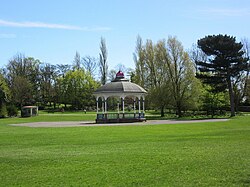| Locke Park | |
|---|---|
 Locke Park in Barnsley | |
 | |
| Type | Municipal |
| Location | Barnsley, South Yorkshire, England |
| Created | 1861 |
| Open | All year |
Locke Park is a 47-acre (19-hectare) public open space and one of the largest outdoor green spaces in the Metropolitan Borough of Barnsley, in South Yorkshire, England. [1]
Contents
In 1861, Phoebe Locke, widow of railway pioneer Joseph Locke donated the park for the benefit of the people of Barnsley. Phoebe gave the original 17 acres (6.9 hectares), and the layout was undertaken by Locke's business partner, John Edward Errington. The park was extended in 1874, when Phoebe Locke's sister, Sarah McCreery donated a further 21 acres (8.5 hectares) in memory of her sister, who had died in 1866. There were further donations and additions of land to bring the park up to its current 47 acres (19 hectares). [2]
The park is listed at Grade II on the Register of Historic Parks and Gardens of Special Historic Interest in England, being added in April 2001. [3]


